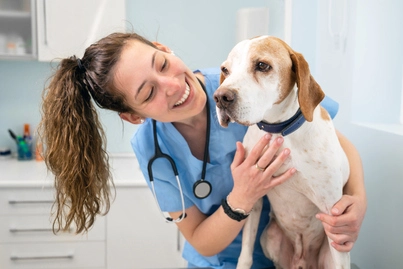There is nothing worse than your dog limping or being in pain, and you don’t know why. It hurts our hearts to see our babies in pain, and frantically we begin searching to find some answers and insight.
Especially when it comes to our English Bulldogs, these dogs have a range of health issues due to their breeding, and limping is one of these. It can cause problems with signs of lameness or limping.
Now, limping can sometimes be nothing serious, and just the way your dog has slept and can wear off. But when it doesn’t clear up, it can lead to issues, and we are here to find out what it could mean!
Keep reading for all the reasons why your English Bulldog could be limping and when you should call the vet!

Why is my English Bulldog Limping?
Let’s get straight into it! There are many reasons your English Bulldog is limping, and we will cover them all today, but let’s start with the most common.
Often, your dog will be limping because they have strained a tendon, ligament, or muscle. These soft tissue injuries are common with English Bulldogs and are usually caused by your Bulldog exerting themself while playing or on a walk. If this is the case, the limping usually begins immediately.
A vet can diagnose a soft tissue injury, and usually fairly quickly too! If your dog is in pain or you are concerned about the limping, take them to the vet for a consultation. The vet will usually prescribe some painkillers to help with the pain your dog is currently in.
The usual advice is to ensure your English Bulldog has time to rest, recuperate, and avoid jumping and running. Avoid walking your dog and any indoor play, and in a few days, you should see an improvement. It’s worth noting that this advice won’t apply to every English Bulldog, and you should follow the advice your vet gives you if it is different from this.
Before calling your vet, there are a few checks you can carry out at home too. These can help your vet diagnose your English Bulldog’s limp and provide you with the answers that you need.
These include:
- Checking for broken toes and claw nails
- Checking for visible bleeding or cuts on your dog’s paw
- Checking for any splinters or other objects in your dog’s paw
- Check for any visual signs of swelling on or around the area
- Checking if your dog is not eating or is lethargic
If you notice any of these signs, or anything else wrong with your dog, make a note of them so that you give the vet all the information they need to proceed with a diagnosis and treatment plan.
Should I call the vet about my limping Bulldog?
Knowing when to call the vet can be tricky for dog owners and is a personal choice. We recommend calling the vet if there is no obvious indication of why your English Bulldog is limping. For example, if you can’t see any swelling or damage, then call the vet, as your dog might need to undergo some tests to assess what’s causing the limp.
If you notice that your English Bulldog wakes up with a limp and doesn’t stop after 30 minutes, call your vet. Any longer than 30 minutes indicates that the limp isn’t just your dog sleeping awkwardly on their leg and requires medical attention.
Remember that this is simply guidance; if you are concerned, contact your vet immediately. They will be able to offer you advice tailored to your English Bulldog and get you the answers you need quickly!
Connect with a verified veterinarian in minutes. No waiting for appointments or office hours. No high fees. Your pet's health made convenient and worry-free.
As we mentioned earlier, there are many reasons why your English Bulldog could be limping either on their back or front legs. To help you understand the causes, we have broken them down into categories to help pinpoint a potential diagnosis! Let’s get into them now.
Back leg limping: Common Causes in an English Bulldog
Let’s start with the back leg limping. It can be caused by several things, ranging from these common causes to rare and serious conditions! Remember, if you have any concerns, to speak to a vet immediately, as they can offer you tailored advice for your dog.
Commonly, any of the following can cause back leg limping:
Over-exertion
Excessive exercise or even intense playtime can leave your English Bulldog tired and limping. These dogs can get worn out easily and, after a few minutes of heavy exercise, can feel exhausted.
Their limping could be due to exhaustion, and usually, some water and time to recover will help with this limping. If it does persist or becomes worse, then be sure to consult a vet.
Injured claws
Limping can also be a sign of an injured or broken claw. These injured claws can be incredibly painful, especially if the tear in the claw is near the nerve ending.
Be sure to take your dog to the vet if you suspect it’s a broken or injured claw so it can be treated correctly.
A wound or insect sting
Your English Bulldog could have a splinter in their paw, making them limp. An open wound, a stone, chewing gum, or even an insect bite or sting could cause a limp.
Be sure to check the paw thoroughly for any signs of a wound or sting. In these cases, you will need to see a vet to clean and dress any wounds and offer medication if needed.
Strain or muscle injury
Another common cause could be a strained leg, joint, or muscle while playing or even just daily walking and playing. A strain can repair ]itself in these cases, but it’s always worth speaking to a vet or booking an appointment for tailored advice and a treatment plan.
As you can see, these common causes can be rectified fairly easily and shouldn’t leave your dog out of action for too long. But what about the more serious conditions a limp could be a sign of? Let’s dive into those!
Back Leg Limping: Serious Conditions your Bulldog could have!
While the chances are strong that your English Bulldog’s limping isn’t anything serious, it’s always best to know what else it could be. After all, you don’t want to leave your dog in pain while you think the limp will rectify itself. Let’s take a look at what some of those serious conditions would be.
If you are concerned your dog’s limp could have any of these issues, be sure to contact your vet immediately so your English Bulldog can be examined immediately.
Breaks, fractures, and dislocations
English Bulldogs are prone to leg injuries, unfortunately. It’s mostly down to their genetics, and they can easily hurt themselves while playing or walking. A break, fracture, or dislocation can be extremely painful for your dog, and you must seek medical help.
Ligament damage
Torn ligaments or ligament damage can occur when your dog twists and jumps. Ligament damage is incredibly painful for your English Bulldog, but thankfully can be fixed easily by a vet!
Hip or elbow dysplasia
As with other brachycephalic breeds, English Bulldogs are also prone to hip or elbow dysplasia. Hip dysplasia is seen in the back legs, whereas we commonly see elbow dysplasia in the front legs and paws.
Luxating patella
It sounds like a scary medical term; luxating patella refers to a dislocated kneecap. It’s another common injury with English Bulldogs, and we often see it first with a limp. Commonly it’s seen on the back legs of your dog, and your first sign is your English Bulldog limping in pain or skipping.
Inflammatory disease
Inflammatory disease or panosteitis is commonly seen in English Bulldog puppies. The inflammation is usually concentrated on their leg bones, and your puppy will be shifting from leg to leg to balance their weight.
Bone cancer
We usually see canine bone cancer in large dog breeds, but it’s not uncommon in English Bulldogs. To find out if your dog has cancer, the vet can perform a simple blood test, and the results are often back quickly.
ACL injuries
Not just for footballers, your English Bulldog could also have an ACL injury! ACL tears often affect the back legs, and you should notice it first when your dog starts to lift their leg.
An operation will be required to rectify this tear. The recovery time varies from dog to dog, but you might see your English Bulldog up and walking again within 60 days. Remember to follow the advice of your vet carefully so your dog can recover fully.
Arthritis
Arthritis is commonly seen in older dogs, where limping becomes a gradual thing. The joints will swell over time, and your English Bulldog can find walking and playing more difficult.
A vet can prescribe medication for the pain and therapy, too, that can help to alleviate your dog’s discomfort.
Lyme’s disease
Lyme disease could also be the cause of your dog’s limping. It’s hard to diagnose, as it takes months after being exposed to Lyme before your dog starts to limp. Thankfully, it can be treated with antibiotics.
Valley fever
Valley fever is a fungal disease found in the United States. It can impact English Bulldog puppies or older dogs and leave them limp. It doesn’t discriminate based on age, and you must seek medical help if your dog becomes limp.
Neurological disorders
Neurological disorders are often caused when the spine has been damaged. A disc will touch nerves, leading to lameness in your English Bulldog. An injury usually causes this, although it can be caused by too much playtime or a dodgy jump and landing.
Limping on Front Leg or Paws, Why?

Now that we have covered what can cause lameness and limping on your dog’s back paws and legs, let’s look at what could be causing the limping on your dog’s front leg or paws.
Elbow dysplasia
Elbow dysplasia is common in English Bulldogs and is caused by abnormalities in the elbow joints on your dog’s front legs. These can be caused by cartilage fusing to the bone, pushing the elbow joint out of place.
As you can imagine, that is very painful for your dog and will result in obvious swelling. They will need medical attention to rectify this issue.
Hip dysplasia
Hip dysplasia occurs when your English Bulldog’s hip joints haven’t formed correctly when they were a puppy. If your dog has this, they probably won’t be able to walk upstairs, jump up, and will walk with a little bunny hop.
Hip dysplasia can be quite painful for your English Bulldog, so be sure to take them to a vet if you are concerned about this.
What the Vet will do
Vet appointments can be traumatic for dogs and owners alike, so having a heads up of what to expect can go a long way to calm your nerves and help you keep your Bulldog calm.
When a vet examines your English Bulldog to understand why they are limping, they generally use just their hands. They will press and pull on your dog to see what the cause could be. Often the inspection will follow this pattern:
- The vet will examine the paws for any signs of injury
- The legs are pulled to stretch them and see if there is a reaction
- All four legs are gently massaged to check for abnormalities or signs of pain
- Pressure is lightly applied to the spine to see if your Bulldog shows any signs of resistance.
Generally, this examination is enough, and your vet should be able to offer you a diagnosis and treatment plan. If not, more in-depth tests can take place to diagnose your English Bulldog.
These can include blood tests, X-rays, MRI scans, and a Fluoroscopy. It is rare that after these tests have been carried out, a diagnosis has not been found. Be aware that you might need to wait a few days for blood test results to come back, and during this waiting time, your vet will instruct you on how best to care for your English Bulldog.
How can I stop my English Bulldog from getting leg injuries?
None of us like seeing our dogs limping or in pain, and will do anything we can to avoid it. Thankfully, we can do a few things to avoid our English Bulldog‘s getting leg injuries and limping! These can all be incorporated into your daily life easily to keep your dogs from harm. Let’s take a look at them now!
- Don’t let your English Bulldog jump too high up, as this can jar their spines.
- Avoid overworking or over-exercising your Bulldog, especially in hot weather.
- Don’t let them walk on surfaces that are too cold or too hot
- Avoid walking on sharp or uneven surfaces that have debris, as these can damage their paws
Final thoughts
And just like that, we have come to the end of today’s article! As you can see, English Bulldogs are prone to limping injuries, ranging from minor to severe.
Remember that if you can’t find the obvious reason your dog is limping or your Bulldog is arching their back, consult a vet immediately for tailored advice and a diagnosis.

